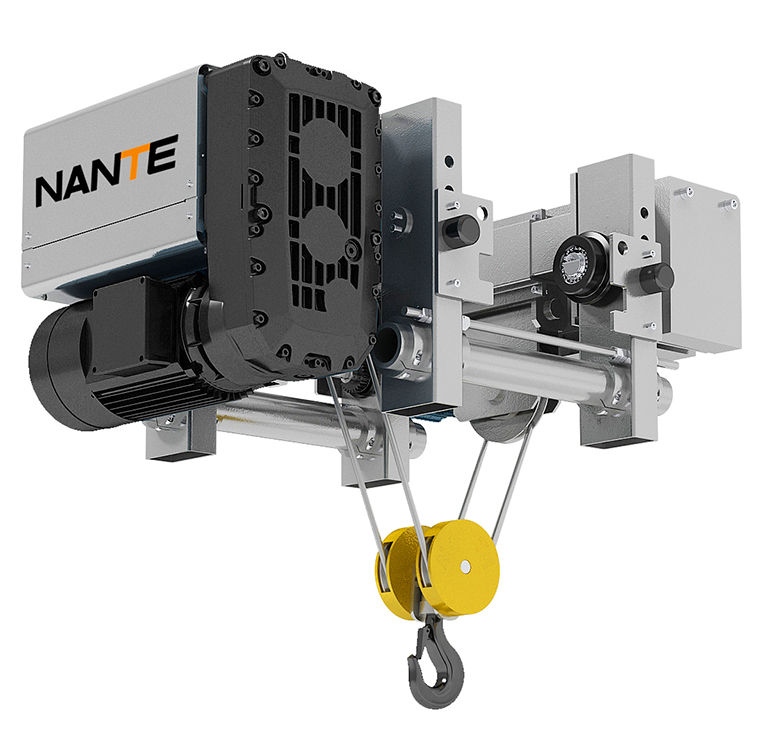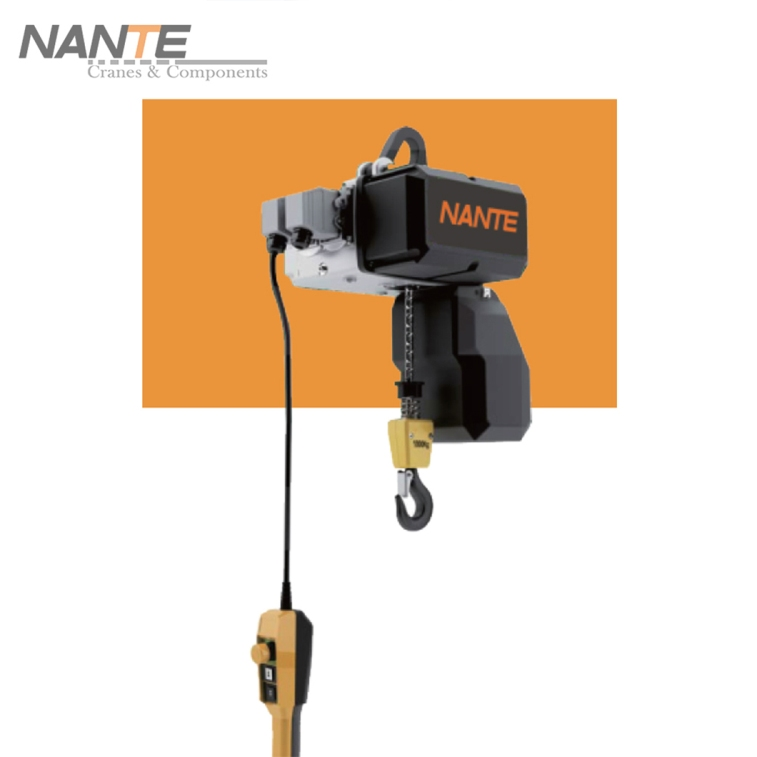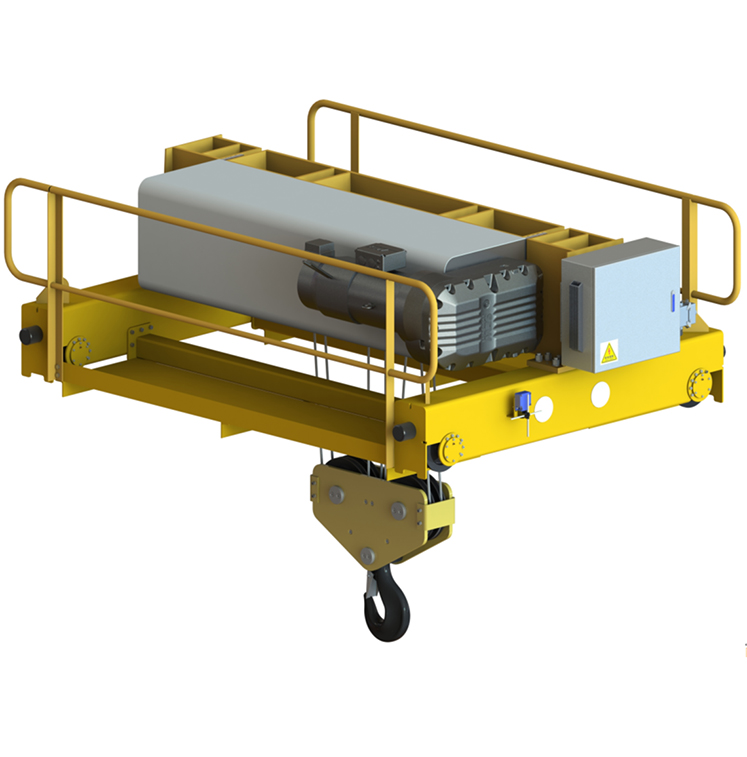Electric Chain Hoists and Electric Wire Rope Hoists
Date: 2024-02-02 Share:
Overview of Electric Hoists
An electric hoist is a special lifting equipment, installed in the overhead crane, or gantry crane. The electric hoist is small in size, lightweight, easy to operate, easy to use and other characteristics, used in industrial and mining enterprises, warehousing, docks and other places.
Electric hoist compact structure, motor axis perpendicular to the reel axis of the electric hoist using worm gear transmission device. The hydraulic system is double control, the relief regulating valve, and magnetic contact pressure gauge can accurately control pressure. The electrical control department adopts low voltage control, which increases the safety of the dominant system.

Principles of Electric Chain Hoist and Electric Wire Rope Hoist
Electric Chain Hoists
Electric chain hoists use a load chain as the lifting medium. The load chain is pulled by a motor, which converts electrical energy into mechanical energy used to lift the load. The electric hoist motor is mounted in a heat sink enclosure, which is usually made of aluminum. The hoist motor is equipped with a cooling fan to dissipate heat quickly during its continuous operation and to enable it to operate in hot environments.
Electric chain hoists are suspended above the object to be lifted by hooking or mounting them on a rigid structural frame. A hook is attached to the end of a load chain that grabs the object. To start the lifting operation, the worker turns on the lifting motor. The motor is equipped with a brake; the brake is responsible for stopping the motor or keeping it driving the load by applying the necessary torque. During the vertical displacement of the load, the power supply is continuously released through a circuit breaker.
A motor generates torque and transmits it to a series of gears within the gearbox. The force is concentrated as it passes through the series of gears which rotate the sprockets to pull the load. As the object gains distance from the ground, the length of the load chain is collected in a chain bag, usually made of highly abrasion-resistant fabric or a plastic drum. The chain bag must ensure that the chain does not tangle and slides freely. The load chain needs to be lubricated for smooth and safe operation.
Electric chain hoists are equipped with a limit switch that signals the motor to automatically stop when the load exceeds the rated load. They can move the load from one position to another when the load is attached to the cart. Load positioning as well as emergency stop can be operated by the worker through the controller.
Electric chain hoists have lower maintenance costs and are easier to install than electric wire rope cranes. They can be used in a variety of environments. Using an electric chain hoist is a cost-effective option.

Electric Wire Rope Hoists
Electric wire rope hoists utilize wire rope as the hoisting medium to lift loads. The wire rope consists of a core wire running through the center of the rope and several strands of steel wire wrapped around the core wire. This construction creates a higher-strength composite rope. Wire ropes used for hoisting applications are typically made from carbon steel, stainless steel, monel alloys and bronze; these materials are highly resistant to abrasion, fatigue, wear and corrosion.
Electric wire rope hoists, like electric chain hoists, are equipped with a hoisting motor with an integrated braking system. They also utilize a series of gears in the gearbox to amplify the torque transmitted by the motor. The concentrated force from the gearbox is transferred to a spline shaft. The spline shaft then turns the reel. As the wire rope is pulled to move the load vertically, it is wrapped around the reel. The rope guide moves around the reel and places the rope correctly in the groove, which extends in a spiral on the side of the reel. The rope guide prevents the rope from tangling. The wire rope also requires lubrication.
Electric wire rope hoists are also equipped with nearly identical positioning controls and safety features as electric chain hoists.
Electric wire rope hoists can lift heavier loads over longer lifting heights. They are typically used for heavy and fast-lifting applications. They are more capable of lifting and supporting loads for long periods. However, in some cases, wire ropes may not be as durable as load chains. They are also more expensive than motorized chain hoists.

Considerations in Electric Hoist Selection
When choosing an electric hoist, the following factors need to be considered:
Lifting height: choose the right electric hoist according to the height of the plant to ensure that the lifting height of the electric hoist can meet the demand. Special occasions can be non-standard designs according to user requirements.
Lifting speed: according to the actual production needs to choose the appropriate lifting speed. General electric hoist lifting speed is divided into single-speed and double-speed two. Double-speed electric hoist is usually used in mold assembly workshops, and for general cargo handling, handling only needs to choose a simple single-speed electric hoist.
Using environment: consider the use of the environment on the requirements of the electric hoist, such as flammable and explosive occasions need to be matched with an explosion-proof electric hoist, cleanroom use of electric hoist needs a special cleanroom electric hoist, can not have oil and rust spots. In the case of limiting the height, you need to use a low-clearance electric hoist or a European electric hoist.
Parameter requirements: first determine the weight of the material to be lifted, and then determine the rated lifting capacity of the electric hoist. For example, if the weight of the material is 3 ~ 4 tons, then you need to choose the rated lifting capacity of 5 tons of electric hoist.
Manufacturer: Choose a large manufacturer with production qualifications to ensure that the quality of the electric hoist is reliable. The quality of electric hoists produced by some small workshops in the market is poor, so we suggest purchasers identify carefully and check the product certification and manufacturer information.
Appearance and performance: check whether the appearance of the electric hoist is intact and whether there is deformation, cracks, defects, and so on in each part. At the same time, check whether the electrical system is working properly and whether the wires are worn and aged. In addition, the inspection of wire rope is also essential to ensure that there is no broken wire, entanglement, and so on.
Safety: Consider the safety performance of the electric hoist, such as whether it is equipped with overload protection, short-circuit protection, and other functions.
Maintenance and upkeep: Understand the maintenance and upkeep requirements of the electric hoist to ensure that it can maintain its performance and safety in the process of use.
 English
English






